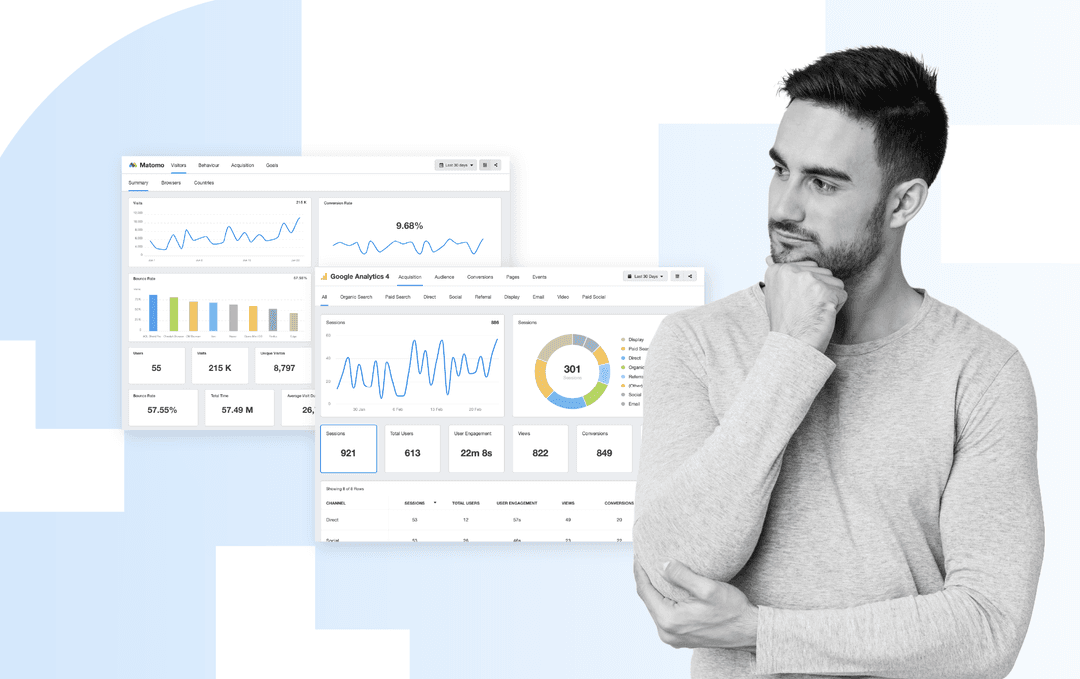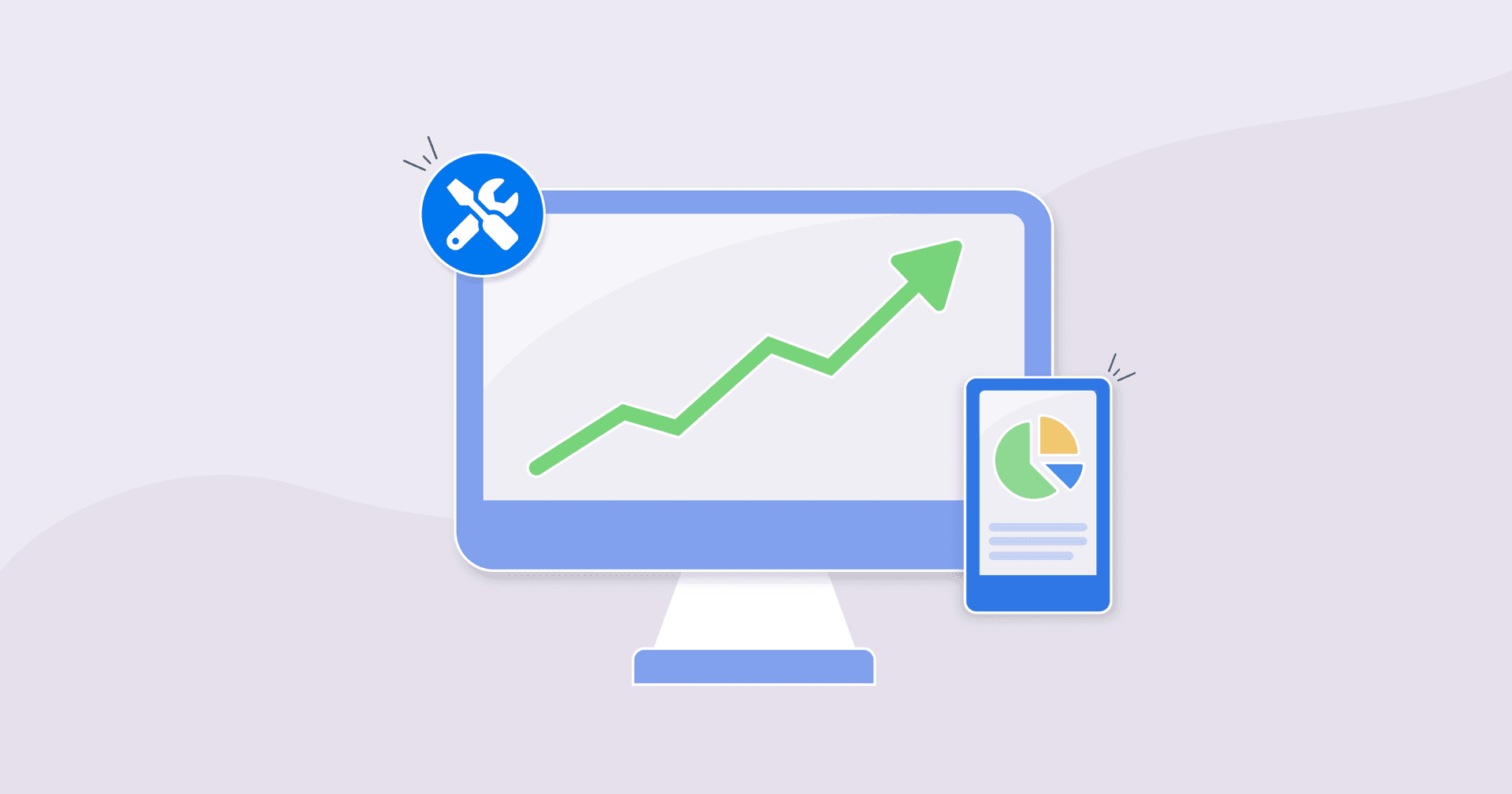Table of Contents
QUICK SUMMARY:
As Google Analytics continues to generate mixed reactions, Matomo is gaining renewed attention for its user-friendly interface, full data ownership, and built-in privacy features. This article explores why more agencies are re-evaluating their analytics stack and how Matomo is emerging as a practical alternative to Google Analytics. It also shares the importance of using a client reporting tool like AgencyAnalytics to consolidate data across Google Analytics, Matomo, and 80+ platforms.
For years, Google Analytics was the default. If you wanted to track website traffic, user behavior, or conversion paths, it was the obvious choice. Today, with GA4 firmly in place, it’s clear the platform has fundamentally changed how teams interact with their data… and not everyone’s on board with the shift.

These changes have opened the door for alternatives, with more and more agencies re-evaluating what “best in class” looks like. One name that keeps coming up? Matomo. While this platform isn’t new, it’s getting renewed attention for good reason. It offers full web analytics data ownership, dedicated user privacy features, and a reporting experience that feels far less complicated. And in a time when teams are looking to simplify workflows—not add more steps—those advantages are hard to ignore.
So here’s the question: Is it time to rethink your analytics stack? In this article, we’ll share the rundown on both platforms, including detailed feature breakdowns and where each tool excels. That way, it’ll be easier to decide on the right web analytics tool for your agency.
What is Matomo?
Matomo is a web analytics platform used to track website traffic, user behavior, goals, and conversions. It’s built around privacy, offers data ownership, and doesn’t rely on third-party cookies or send data to outside servers. Instead, users can choose to host it on their own servers or use a secure cloud version. This makes it a strong option for agencies that need more control over data management, especially those that manage clients with strict privacy or security requirements.
Matomo’s Standout Features
Matomo offers a suite of features that are centered around flexibility, transparency, and compliance–here’s a quick overview.
Feature | Description |
|---|---|
Privacy Compliance | Matomo is built with privacy in mind, offering full compliance with GDPR, HIPAA, and CCPA. It also comes with built-in tools for consent management and data anonymization. |
Self-Hosting Option | Users have the option to host Matomo on their own servers, which gives them complete control over data storage and security. |
No Data Sampling | Unlike some platforms that rely on sampling, Matomo delivers 100% unsampled data for more accurate reporting. |
Tag Manager | A built-in tag manager allows marketing teams to manage tracking codes without third-party tools. |
Heatmaps & Session Recording | Features like heatmaps and session recordings offer visual insights into how users interact with the site, including scrolling behavior and clicks. |
Goal & Event Tracking | Easily set up and track custom goals and events such as form submissions, downloads, or purchases. |
Multi-Channel Attribution | Multi-channel attribution helps identify which traffic sources are contributing most to conversions. |
Powerful Integrations | Matomo supports integrations with popular CMS platforms like WordPress, WooCommerce, and Drupal. |
Together, these features make Matomo a flexible and privacy-conscious analytics solution.
Matomo's Timely Rise
Before Matomo, there was Piwik Analytics. First established in 2007, this platform steadily grew, hitting its first major milestone of 1 million downloads in 2012. When 2018 rolled around, they amassed a whopping 100,000 active users. At this point, the company rebranded as Matomo Analytics, reflecting a new chapter focused on privacy-first analytics, flexible hosting options, and greater data ownership.
Since then, Matomo has carved out a space among organizations that prioritize transparency and control. However, it was the rollout of Google Analytics 4 that unexpectedly pushed Matomo into the spotlight. It filled a gap that many users were craving: An alternative web analytics solution that prioritized the user.
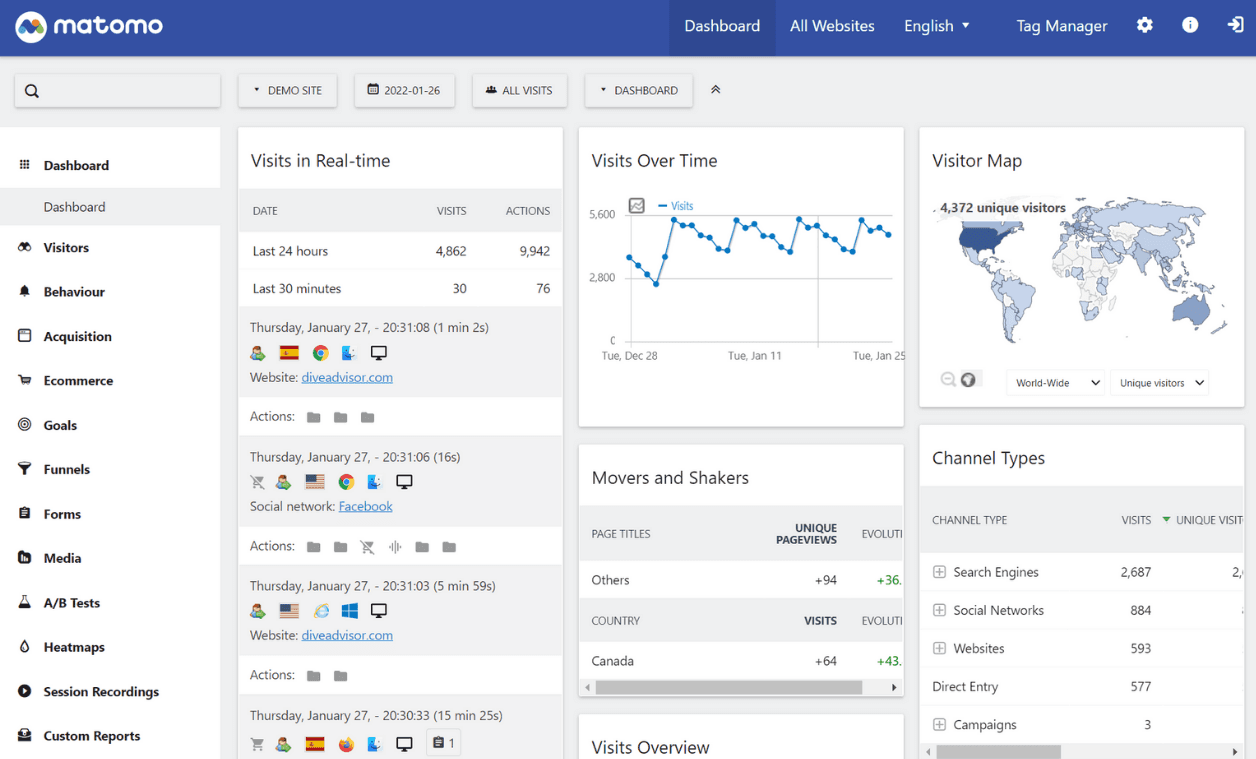
It's not often that an ad campaign captures a cultural moment, but Matomo's Googleheimer Countdown managed to do just that. Released in the final weeks before the Universal Analytics sunset, the tongue-in-cheek ad spoofed both Google’s mandatory transition and the cultural buzz around Oppenheimer.
The campaign resonated with marketers who felt steamrolled by GA4’s rollout, positioning Matomo as a defiant, user-first alternative.
What is Google Analytics?
Google Analytics is a widely used platform that helps businesses understand how users interact with their websites and apps. It’s also used to track key website performance metrics like traffic sources, user behavior, and conversions.
In 2023, Google Analytics 4 (GA4) replaced Universal Analytics as the default version. GA4 offers a more flexible event-based model, cross-platform tracking, and deeper integration with Google’s advertising tools. It was designed to align with a privacy-conscious, cookieless future. While some time has passed since its initial rollout, these changes forced marketers to rethink how performance data is collected, interpreted, and reported.

Still navigating a complex interface? Use an easy-to-understand Google Analytics reporting tool instead. Invest in a reliable client reporting tool with live 24/5 customer support–try AgencyAnalytics, free for 14 days.
GA4’s Standout Features
GA4 introduced a fundamentally different approach to web analytics, compared to its predecessor, Universal Analytics. Below are some of the key features that defined this shift.
Feature | Description |
|---|---|
Event-Based Tracking | GA4 uses an event-based tracking model. Every user interaction—such as clicks, scrolls, or downloads—is treated as a distinct event. |
Cross-Platform Analytics | This platform allows businesses to combine data from both websites and mobile apps into a single reporting view. |
Predictive Metrics | GA4 uses machine learning to forecast user behavior, such as purchase probability or risk of churn. |
Audience Triggers | Create remarketing audiences based on real-time user behavior on their sites or apps. |
Privacy Controls | GA4 includes features like consent mode, IP anonymization, and customizable data retention settings to support compliance with global privacy laws. |
Enhanced Google Ads Integration | GA4 integrates seamlessly with Google Ads, making it easier to analyze attribution and optimize marketing campaigns across platforms. |
BigQuery Export | Export raw event data to BigQuery for advanced custom analysis and long-term data storage. |
While it comes with a learning curve, GA4’s robust capabilities make it a powerful tool for tracking website analytics data.
The Rise (And Fall?) of Google Analytics
Many marketers still consider Google Analytics one of the best web analytics tools. That said, the revamped version hasn’t been “universally” well-received.
Since its launch in 2005, Google Analytics quickly rose to the top by offering a free, powerful tool that democratized access to website performance data. Businesses of all sizes could easily track traffic, analyze user behavior, and optimize digital strategies. Over time, Google expanded those capabilities, further cementing their position as the industry leader.
Fast forward to 2020. Pitched as the future of web analytics, GA4 was introduced as a more modern, privacy-centric alternative to Universal Analytics. Rather than encouraging users to switch, though, the forced migration raised a lot of eyebrows. New accounts automatically defaulted to GA4, and hints began to drop that Universal Analytics would eventually be phased out. The rollout caught many long-time users off guard, sparking confusion, frustration, and a wave of hesitation across the industry.

One particularly frustrating aspect of the GA4 transition was the barrage of confusing (and often intrusive) reminder pop-ups. These alerts frequently hijacked the screen, disrupted daily workflows, and created a disjointed user experience. They also appeared regardless of whether users had already completed the migration. This disruption only deepened frustration, chipping away at the goodwill long associated with Google Analytics.
Even after the migration dust settled, there’s still lingering frustration with GA4. The interface, though more advanced, is seen as unnecessarily complex. Simple tasks like tracking pageviews or building reports now take more clicks, longer setup, and a stronger grasp of event-based tracking.
With all these added hurdles, it’s no surprise that more teams are exploring alternatives that offer clarity without the learning curve.

Matomo’s Solutions to GA-4 Pain Points
This discontent is precisely what Matomo Analytics capitalized on. Let's break down specific user frustrations with GA4 and explore how they've indirectly fanned Matomo's flames.
Complexity
Even years after its rollout, GA4’s complexity continues to be a major hurdle. What used to be a straightforward setup with Universal Analytics has turned into a multi-step process involving Google Tag Manager, event configuration, and custom parameters. For agencies managing multiple clients, that setup time adds up quickly.
The learning curve doesn’t stop at setup. Even routine tasks–like tracking custom conversions–now require extra steps.
One benefit of GA4 is that it has more built-in conversions. Any custom conversions will need to be reprogrammed. This takes some adjusting, as they must first be created as "events" in Tag Manager or GA4 and then marked as conversions.
Molly Lopez, Founder and CEO, Sparo Marketing
In contrast, Matomo offers a more streamlined experience. Installation is simpler, the UI is more familiar to those coming from Universal Analytics, and custom goals can be created without jumping between multiple platforms.
Data Control
While there’s no shortage of Google Analytics data, there are limits to how those raw insights are accessed, stored, or exported (especially without a BigQuery setup). For agencies that rely on flexible data handling or custom integrations, this creates even more friction.
Matomo takes the opposite approach. Whether hosted in the cloud or on personal servers, users retain full ownership of their data. It’s far easier to export or filter Matomo metrics, making it more adaptable for custom reporting.
Lack of Certain Features
GA4 also drew criticism for removing or reshaping core features that were staples in Universal Analytics. For example, detailed audience segmentation, customizable reports, and certain attribution models were either watered down or eliminated entirely.
It was like throwing a wrench into well-oiled machinery; suddenly, digital marketers had to rethink strategies they'd honed and tested over many years. This situation created a window of opportunity for Matomo, which retains many of the features left by the wayside in GA4.
Even though it's really not an accurate metric from a real-world perspective, I will miss the former bounce rate in Google Analytics. Call me sentimental.
Rick Hogan, CEO and Co-Founder, Bleevit
Confusing Reports
In an attempt to offer more advanced capabilities, GA4 introduced new types of reports that may seem less intuitive compared to previous versions.
This has led to increased time spent on training and adaptation, slowing down processes that used to be straightforward. Matomo, on the other hand, retains an easily comprehensible reporting structure. This allows users to hit the ground running without sifting through convoluted data displays.
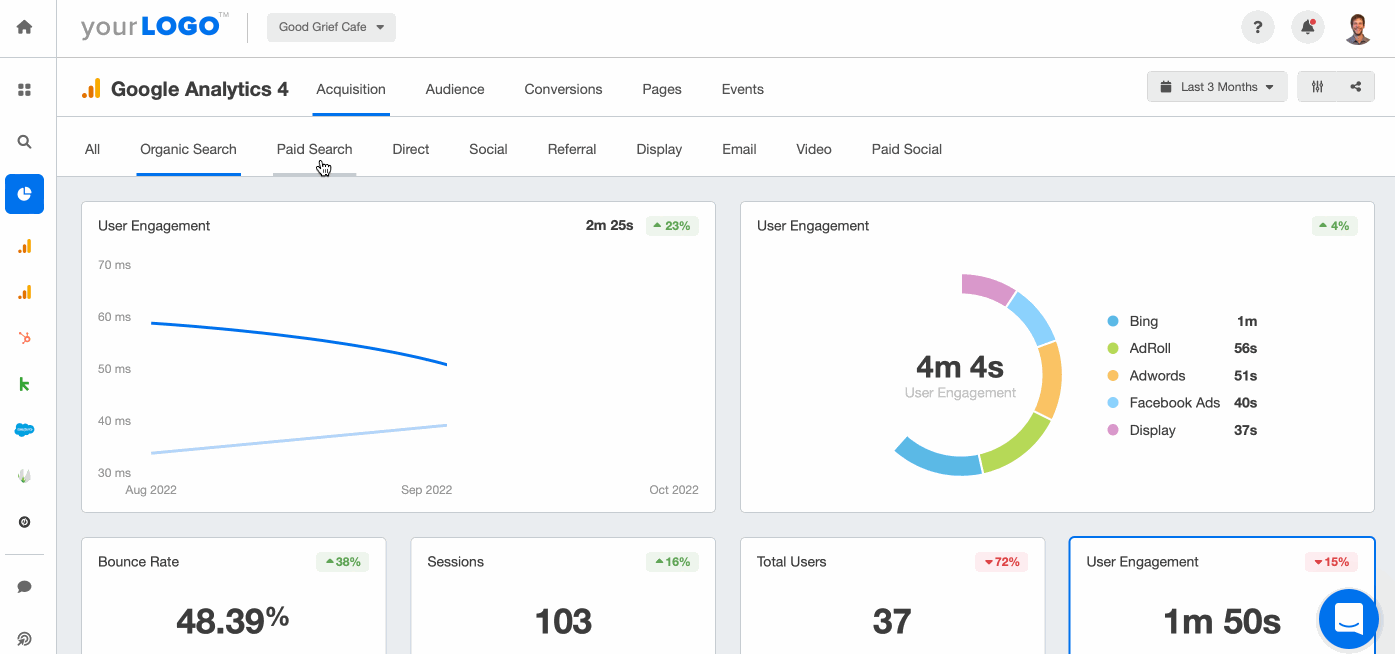
Simplify complex data by using pre-built, fully customizable Google Analytics reports in AgencyAnalytics. Monitor real-time performance, generate AI-powered insights, and more–sign up for a free 14-day trial.
Data Thresholding
When web traffic reaches a certain level, many users notice that GA4 limits the granularity of available data. It’s a serious concern for larger sites, content marketing initiatives, or rapidly growing campaigns that require on-demand accuracy. Matomo sidesteps this issue by not imposing arbitrary data limits, providing users with the detailed information they need when they need it.

The list goes on, but suffice it to say that GA4 has given users plenty of reasons to seek alternatives, and Matomo is happy to oblige.
The Great Web Analytics Showdown: Matomo vs Google Analytics
While both platforms have unique advantages, they also have (or lack) features that could be potential deal-breakers. To help your agency make an informed choice, let's delve into more detail.
GA4 vs Matomo: Feature-by-Feature Comparison
While both GA4 and Matomo serve the same core function–web analytics–their approach, flexibility, and user experience differ in key ways. The table below breaks down how each platform handles essential features.
Feature/Capability | Google Analytics 4 | Matomo |
|---|---|---|
Tag Management | Google Tag Manager | Matomo Tag Manager |
Form Analytics | Available | Available |
Server Log Analytics | Not Available | Available |
User-Friendly Interface | Moderate | Highly User-Friendly |
Database Support | Proprietary | MySQL Database |
Data Control | Limited | Full Control |
Historical Data | Limited | Available |
JavaScript Tracking | Available | Available |
Google Ads Integration | Seamless | Requires Configuration |
Free Tool | Limited Free Version | Limited Free Version |
Hosting | Cloud Only | Matomo Cloud or On-Premise |
Security Features | Standard | Security Bug Bounty Program |
Event Tracking Capabilities | Available | Available |
Custom Dimensions | Available | Available |
Data Limits | Thresholding | No Limits |
Automated Tests | Not Available | Automated Integration Tests |
WordPress Compatibility | Available via Plugin | Available via Plugin |
Both tools offer valuable insights into website traffic and campaign tracking. However, your choice should align closely with specific client needs and goals.
Usability, Setup & Customization: How the Platforms Compare
While the above feature comparison highlights what each platform offers, this next section explores what it’s actually like to use them. Here’s how Matomo and Google Analytics compare in terms of setup, ease of use, flexibility, and day-to-day management.
Criteria | Google Analytics 4 | Matomo |
|---|---|---|
Installation Process | Requires JavaScript tracking code; installing Google Analytics may get complicated with a tag management system. | Simple setup–Matomo can be self-installed and does not require JavaScript for server-side tracking. |
Tracking Features | Has basic tracking features and integration with session recording tools; limited visibility into specific page-level interactions. | Includes advanced tracking features, session recordings, and exit page analysis, providing comprehensive insights into on-page visitor data. |
Ease of Creating Reports | Moderate complexity; building advanced reports requires technical knowledge and more setup time. | Easier to use; intuitive dashboard allows quick report creation without a steep learning curve. |
Customizability & Flexibility | Includes advanced features but with constraints, such as data analytics limits, lack of server-side access, and limited customization options. | Highly customizable; supports unlimited users and broader feature access with fewer platform-imposed restrictions. |
User Interface & Ease of Use | More complex interface; may require extra time and training to navigate effectively. | Intuitive and user-friendly; easy to navigate even for first-time users or non-technical teams. |
Functionality & Capabilities | Supports advanced features like roll-up reporting and manual queries (e.g., via BigQuery), but often requires technical setup. | Offers similar capabilities with a more straightforward and intuitive user interface, which is ideal for daily workflows. |
Data Ownership & Privacy | Data owned by Google; limited control over what's collected and stored. | Full control over data; includes on-premise collection for added privacy and compliance. |
Support | Offers free support resources with more assistance for premium tiers; issue resolution may take time. | Open-source with strong community support; typically quicker issue resolution. |
Pricing | The free Google Analytics option has some limitations; paid plans are required for advanced features. | Free version available; paid plans include full features with no data limits. |
So, what’s the verdict in the Matomo-Google Analytics debate? As we’ve outlined, both platforms have strengths. However, the right choice depends on your agency’s needs and what clients prioritize. As a quick reference:
GA4 integrates seamlessly with Google Ads and other Google tools, but its interface is complex, and data access may be restricted due to thresholding.
Matomo offers full data control, a user-friendly interface, and the flexibility to self-host. It also supports a MySQL database connector for easier data integration and runs a Security Bug Bounty Program for added transparency and trust.
With that said, agencies focused on advertising and predictive insights may prefer the Google Analytics platform. On the other hand, those prioritizing data ownership, flexibility, and clearer reporting could lean toward Matomo.
Should You Use at Least One Google Analytics Alternative?
If your agency has relied entirely on Google Analytics, you’ve likely experienced disrupted workflows. And that shift alone is a strong reason to reconsider a single-platform approach.
Adding an alternative to Google Analytics acts as a safeguard. It gives your agency more flexibility, reduces risk, and ensures you're not dependent on one system for every client report. Plus, different web analytics tools have different strengths. While Google Analytics excels at tracking events and integrates seamlessly with Google Ads, tools like Matomo provide full data ownership and greater data transparency.
This makes it easier to meet diverse client requirements, from compliance-heavy industries to teams needing faster access to insights.
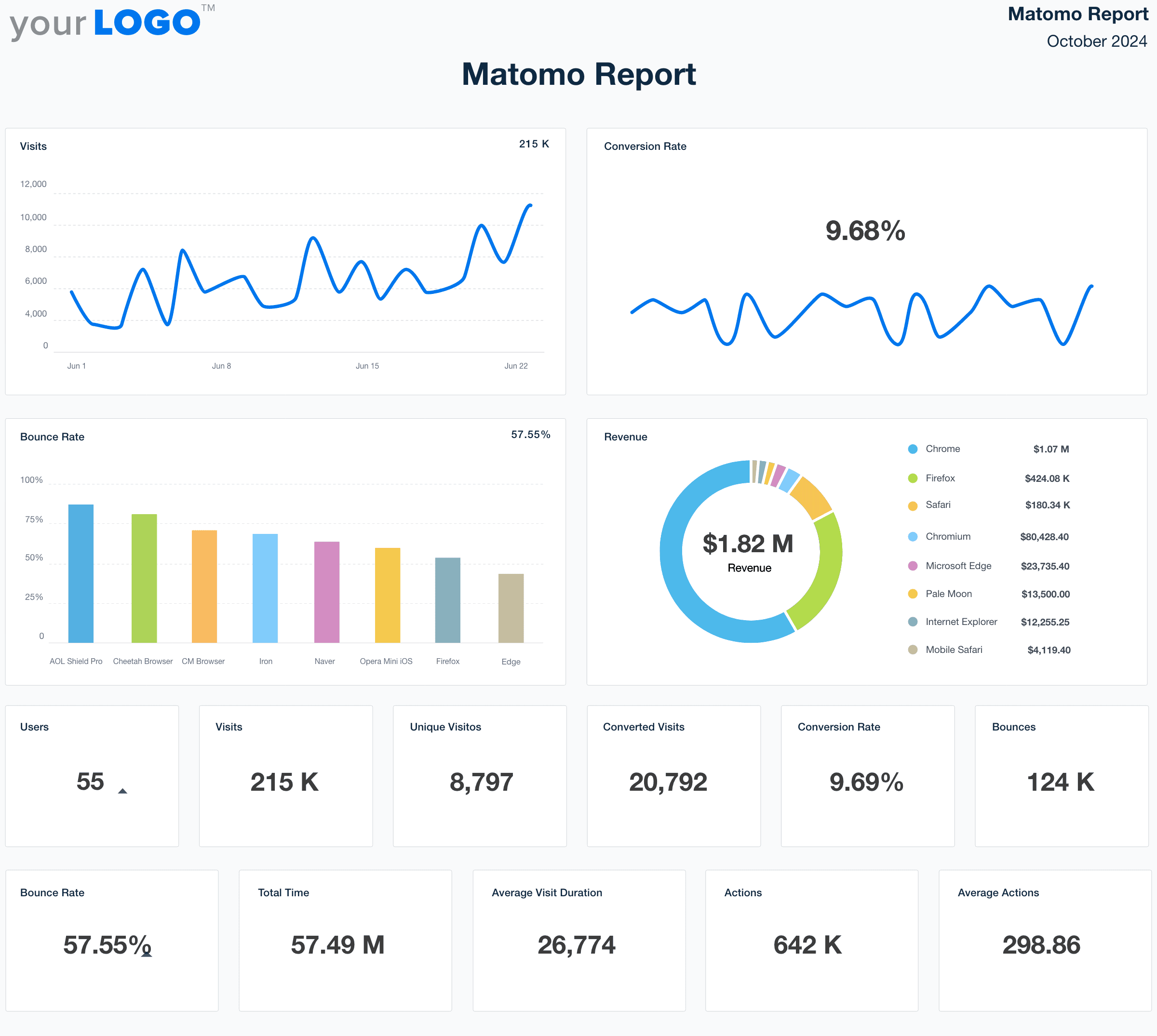
Can’t choose between the two? With AgencyAnalytics, you don’t have to. Automatically consolidate data from Matomo and Google Analytics into professionally designed, visual formats–try it free for 14 days.
There’s also a practical case for redundancy and validation. If Google Analytics experiences downtime or tracking errors, a second platform ensures continued visibility. When both tools show consistent trends, your confidence in the data grows. When they don’t, it signals a deeper issue worth investigating.
Simply put, relying on one tool may add unnecessary risk. Where possible, using a second analytics platform provides greater control, more reliable reporting, and backup coverage when it matters most.
Summary and Key Takeaways
The web analytics landscape is changing. As Google Analytics continues to generate mixed feedback, Matomo is gaining traction, particularly among agencies looking for more control, easier reporting, and transparent practices.
If seamless integration with Google Ads and advanced modeling are must-haves, Google Analytics ultimately may be the best choice. If data ownership, flexible hosting, and usability are more important, Matomo is a strong alternative. In some cases, running both tools in parallel provides the best of both worlds. It’s a way to strengthen validation, minimize the risk of tracking gaps, and ensure reporting continuity if one platform encounters issues.
Whether your agency relies on Google Analytics, switches to Matomo, or leverages both, the real impact comes from how insights are delivered. No need to piece together screenshots, though. Instead, use AgencyAnalytics to do the heavy lifting!
Automate data retrieval across 80+ platforms, create custom dashboards in just a few clicks, and present web analytics metrics in client-ready formats. View all your data in one place: Sign up for a free 14-day trial today.

Written by
Paul Stainton is a digital marketing leader with extensive experience creating brand value through digital transformation, eCommerce strategies, brand strategy, and go-to-market execution.
Read more posts by Paul StaintonSee how 7,000+ marketing agencies help clients win
Free 14-day trial. No credit card required.


